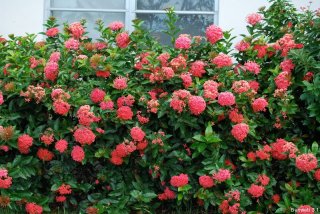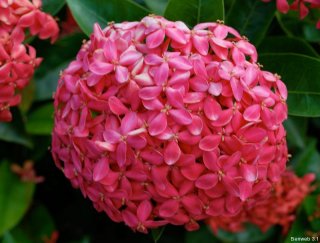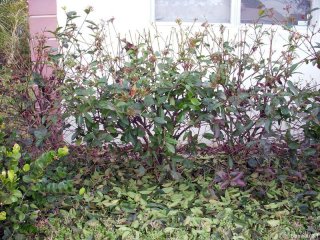People often wonder how they can help reduce their consumption of resources. Whether this question arises out of a laudable desire to help conserve our planet, or an equally laudable desire to help conserve one’s financial capital, the answer, at least sometimes, is to go native. This January, for example, we got a good lesson in the value of native plantings. The picture below is a non-native, but very pretty, flowering shrub in the genus Ixora.
Beautiful, isn’t it? Here’s a close-up of one of the flower clusters:
These flowers attract countless bees and other pollinators, who would probably be better off elsewhere, as Ixora doesn’t really have all that much in the way of nectar for them. It’s a showy cheat, is what it is. But these shrubs are not particularly long-lived, although this hedge on our front lawn has held on quite a bit longer than one might have expected: we’ve been in the house for 9 years, and it was old already when we moved in. Our neighbor, who has been here longer than we have, doesn’t remember our house ever not having these shrubs, so they’re at least 20 years old.
The prolonged cold spell we got this January, though, proved to be a bit hard for this tropical species to handle:
The leaves dropped all over the place, and it looked like the plant was ready to give up the ghost. And, rather than wait and see, I decided to help it along:
I’ve been itching to replace this exotic hedge almost ever since we moved in, and certainly since we redid the entire landscape in plants native to Palm Beach County, with a few exceptions that our landscape designer holds dear: Aristolochia gigantea, for the Polydamas Swallowtail caterpillars; the widespread Asclepias for the milkweed butterflies (Viceroys, Monarchs); and we left one or two of the “foundation” plants like the Areca palms by the entryway, and the Ixora hedge.
But now that hedge is history; soon to be replaced by, well, we know not what. Sabal minor? Coontie? Both? We want a hedge that won’t need clipping all the time, so its ultimate height should only be 4 or 5 feet. That reduces our options considerably. And we already have tons and tons of horizontal cocoplum, so I really don’t want to add more. Walter’s Viburnum would have been lovely, but it needs too much water for this high dry sand we’re on.
We also want a native plant, to provide food and shelter for butterflies and birds that evolved in conjunction with this ecosystem. Plus, the cocoplums and all the other natives did fine during the cold; the only casualties were this hedge in front, and a sister hedge in the back that looks like it might be on its last legs as well…
Stay tuned to see what the in-ixorable march of progress brings to Boca!




